Forza Italia (2013)
Forza Italia[nb 1] (translated to "Forward Italy"[8][9] or "Let's Go Italy",[10][11] known also by its acronym FI) is a centre-right political party in Italy whose ideology includes elements of liberal conservatism, Christian democracy, and liberalism. Its leader is Silvio Berlusconi, former Prime Minister of Italy (1994–1995, 2001–2006, 2008–2011).
Forza Italia | |
|---|---|
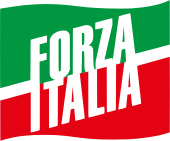 | |
| President | Silvio Berlusconi |
| Vice President | Antonio Tajani |
| Founded | 16 November 2013 |
| Preceded by | The People of Freedom |
| Headquarters | Piazza San Lorenzo in Lucina 4, Rome |
| Newspaper | Il Mattinale |
| Youth wing | Forza Italia Giovani |
| Membership (2015) | 106,000[1] |
| Ideology | Liberal conservatism[2] Christian democracy[2] Liberalism[3] Populism[4][5] |
| Political position | Centre-right[6] |
| National affiliation | Centre-right coalition |
| European affiliation | European People's Party |
| European Parliament group | European People's Party |
| Colours | Azure |
| Chamber of Deputies[7] | 95 / 630 |
| Senate | 55 / 320 |
| European Parliament | 7 / 76 |
| Regional Presidents | 4 / 20 |
| Regional Councils | 74 / 897 |
| Website | |
| www | |
The party, formed out of the former People of Freedom (PdL), is a revival of the defunct Forza Italia (FI), active from 1994 to 2009, when it was merged with National Alliance (AN) and several minor parties to form the PdL. Forza Italia's leading members include Antonio Tajani (President of the European Parliament), Elisabetta Casellati (President of the Senate), Donato Toma (President of Molise), Mara Carfagna, Renato Brunetta, Paolo Romani, Mariastella Gelmini, Anna Maria Bernini, Maurizio Gasparri, Renato Schifani and Stefania Prestigiacomo.
On 11 September 2014 FI was admitted into the European People's Party (EPP), inheriting the PdL's membership.[12]
FI is a much smaller party than the original FI and the early PdL, due to the splits of Future and Freedom (2010), the Brothers of Italy (2012), the New Centre-Right (2013), the Conservative and Reformists (2015) and the Liberal Popular Alliance (2015).[13] In the 2018 general election FI was overtaken by Lega Nord as the largest party of the centre-right coalition.
History
Background and foundation
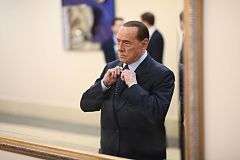
The new FI, announced in June 2013,[14][15] was launched on 18 September[16][17][18][19] and the PdL was formally dissolved into the party on 16 November.[20] The day before a group of dissidents (mainly Christian democrats), led by Berlusconi's former protégé Angelino Alfano, had broken away by announcing the foundation of the alternative New Centre-Right (NCD).[21] Another group of PdL members, led by former mayor of Rome Gianni Alemanno, had left the party earlier in order to form Italy First (they would later join the Brothers of Italy, FdI).[22] According to Berlusconi, the PdL would become a coalition of centre-right parties, including the new FI, Lega Nord (LN), the NCD, the FdI, etc.[23]
Among the supporters of the return to FI, the so-called "hawks"[24] and self-proclaimed "loyalists",[25] a leading role was played by Raffaele Fitto, who, despite the common Christian-democratic background, was a long-time rival of Alfano. Loyalists included Antonio Martino, Renato Brunetta, Denis Verdini, Mariastella Gelmini, Mara Carfagna, Daniela Santanchè, Niccolò Ghedini and Daniele Capezzone, while Maurizio Gasparri, Altero Matteoli and Paolo Romani tried to mediate, but finally joined the new FI.[26][27] The symbol of FI made its return in the 2013 Trentino-Alto Adige/Südtirol provincial elections, although in a regional fashion: "Forza Trentino"[28] and "Forza Alto Adige" (in list with Lega Nord Alto Adige – Südtirol).[29]
On 27 November the Senate approved Berlusconi's expulsion,[30] following the leader's conviction for tax evasion in August, when Berlusconi was sentenced to four years of imprisonment, the last three being automatically pardoned.[31] The day before FI had joined the opposition to Enrico Letta's government,[32] which was still supported by Alfano's NCD instead. The latter voted against Berlusconi's expulsion,[33][34] but since then completely parted ways from FI.
Internal struggles and Toti's rise
As of the end of December 2013, Berlusconi was set to appoint two vice-presidents: Antonio Tajani (European Commissioner and vice-president of the European People's Party) and Giovanni Toti (former editor of Studio Aperto and TG4,[35] two news programs of Berlusconi's Mediaset).[36] As a result of the resentment by the party's old guard, notably including Fitto, on the alleged appointment of Toti also as coordinator-at-large, Berlusconi appointed him merely "political counselor" to the party.[37][38]
In the 2014 European Parliament election FI obtained 16.8% of the vote and 13 MEPs elected, including Toti in the North-West, Tajani (who had first been elected to the European Parliament in 1994) in the Centre and, most notably, Fitto (who garnered more than 180,000 votes in his native Apulia alone) in the South.[39]
Fitto, the strongest backer of Berlusconi's leadership in late 2013, became his main internal challenger by mid 2014. After months of bickering with Berlusconi over the so-called "Nazareno pact" with Matteo Renzi, leader of the Democratic Party and Prime Minister, in February 2015 Fitto launched his own faction, named "Rebuilders".[40] Fitto's supporters included Capezzone, Maurizio Bianconi, Rocco Palese, Saverio Romano, Cinzia Bonfrisco, Augusto Minzolini and most Apulian MPs.[41]
2015 regional elections and splits
In the run-up of the 2015 regional elections the party was riven in internal disputes and was divided mainly in three groups: Berlusconi's loyalists, Fitto's "Rebuilders" and nostalgics of the "Nazareno pact".[42][43] The latter were led by Verdini and some of them, notably including Bondi, were openly pro-Renzi.[44][45] Bondi, a former Berlusconi loyalist, and his partner Manuela Repetti left the party in March,[46][47] while other disgruntled Verdiniani propped up the government from time to time. Berlusconi chose Toti as candidate for President in Liguria, confirmed incumbent Stefano Caldoro as the party's standard-bearer in Campania and renewed their support of LN's Luca Zaia in Veneto.[48] However, Berlusconi and Fitto did not find an agreement on the composition of the slates in Apulia, where the two wings of the party fielded two opposing candidates for president,[49][50][51] and similar problems arose in Tuscany,[52] Verdini's (and Renzi's) home region and stronghold.
Two weeks before the regional election, Fitto left the European People's Party Group in the European Parliament in order to join the European Conservatives and Reformists.[53] He also left FI altogether and launched his own party, named Conservatives and Reformists (CR) too.[54] By mid July, when CR was formally established as a party, nine deputies, ten senators and another MEP had left FI in order to follow Fitto.[55][56][57][58]
In the elections the party lost many votes, mainly to the LN, and gained more than 10% only in three regions out seven (including Apulia, where the party's candidate did worse than Fitto's one, while, in Veneto, a former stronghold, FI barely reached 6%), but, thanks to the LN's strong showing, Toti was elected President of Liguria.
Another split occurred in late July, when Verdini led his group out of the party and launched the Liberal Popular Alliance (ALA).[59][60][61]
Toward a new centre-right coalition
.jpg)
In the 2016 Milan municipal election FI found a strong candidate for mayor in Stefano Parisi, a former director-general of Confindustria and CEO of Fastweb, who pulled the party to 20.2% (virtually double than the LN's score), but however narrowly lost to his Democratic opponent in the run-off, Giuseppe Sala. After the election, FI was basically divided in two camps: one led by Parisi, who did not officially joined the party and proposed a more traditional centre-right "liberal-popular" path, and the other led by Toti, who had formed a strong partnership with Roberto Maroni and Luca Zaia, the LN's Presidents of Lombardy and Veneto, and was supportive of a full-scale alliance with LN and, possibly, of its leader Matteo Salvini's bid to become the leader of the centre-right coalition.[62][63][64] In November, when it was clear that Parisi would not come to terms with Salvini, Berlusconi disowned Parisi,[65][66] who responded by launching his own Energies for Italy (EpI) party.[67][68][69]
Since then, the party has strengthened its position in parliament, thanks to an influx of MPs from other parties, including several returning after years of dissent. In August 2016 the party was re-joined by two senators, including Renato Schifani from the NCD and another from the ALA. In November came Mario Mauro and his Populars for Italy (PpI).[70] Since June 2017 the party was joined by three deputies and one senator from Popular Alternative (AP, ex-NCD), one deputy and one senator from the Mixed Group (ex-Five Star Movement, M5S), one deputy from Direction Italy (DI, ex-CR), one from Solidary Democracy (Demo.S), one from Act! (F!, ex-LN) and two senators from the ALA.[71][70] Particularly, Enrico Costa left AP and resigned from minister of Regional Affairs in Paolo Gentiloni's centre-left government,[72] aiming at forming a "liberal centre" with FI.[73] In the context of a more united centre-right, Costa might form the "fourth leg" of the coalition, after the LN, FI and the FdI, by uniting other AP splinters, DI, F!, Identity and Action (IdeA), the Italian Liberal Party (PLI), the Union of the Centre (UdC), and the Pensioners' Party (PP),[74][75][76] all variously affiliated with FI and the centre-right. Not all FI members were happy with all that, in fact two senators and one deputy, Daniela Santanchè, switched to the FdI.[77]
In January 2017 Antonio Tajani was elected President of the European Parliament, the first Italian since Emilio Colombo (1977–1979).
2018 general and 2019 EP elections
In the 2018 general election FI obtained 14.0% of the vote and was overtaken by the LN for the first time as the largest party of the centre-right. After the election, long-time FI senator Elisabetta Casellati, was appointed President of the Senate, with centre-right's and M5S' support. After months of negotiations, the centre-right fragmented as the LN chose to team up with the M5S and formed a yellow-green government, also dubbed as Government of Change, under Prime Minister Giuseppe Conte.
In July Berlusconi appointed Tajani, who had been previously tipped as candidate for Prime Minister in the run-up of the 2018 general election,[78] vice president and Adriano Galliani coordinator of departments,[79][80][81] in an effort to restructure the party, which was shrinking in opinion polls.
2019 EP election and internal developments
Berlusconi decided to run in the 2019 European Parliament election as FI's top candidate in all Italian constituencies, except for central Italy.[82][83] In the election, FI received only 8.8% of the vote, its worst result ever. Berlusconi was one of the party's elects to the European Parliament and the oldest member of the assembly.[84]
In June Berlusconi appointed Toti and Carfagna national coordinators, with the goal of reforming and relaunching the party.[85] However, after a few weeks, Toti left the party in opposition to Berlusconi[86] and launched Cambiamo!.[87] One of the main reasons for the split was Toti's support of an alliance with the League and the Brothers of Italy (FdI) at country-level, about which Berlusconi was reticent and Carfagna against.
Ideology and factions
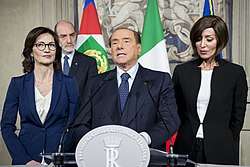
FI's ideology is similar to that of its predecessor, The People of Freedom (PdL), a big tent centre-right party including Christian democrats, liberals, conservatives and social democrats. Indeed, FI presents itself as a "liberal", "Catholic", "reformist" and "moderate" alternative to the left in alliance with the right,[88][89][90] but not rightist itself.[91]
The PdL's break-up and the exit of the New Centre-Right (NCD) left FI with a more liberal base. Generally speaking, with the long-prepared return to FI, Berlusconi aimed at returning to the party's "liberal roots": in doing that, he reinforced his ties with those liberals, like Antonio Martino, who had been marginalised in the PdL,[92] while losing many of its Christian democrats and conservatives to the NCD. However, after NCD's internal struggles, its transformation into Popular Alternative (AP) and several splits, some NCD conservatives have returned to FI. Moreover, in 2015 FI lost several liberal MPs, who formed the Liberal Popular Alliance in support to Matteo Renzi's cabinet.
FI includes several factions and ideological trends. The party's leading faction was long not an organised one: named the "magic circle" by journalists (a reference to a defunct faction within Lega Nord), it was composed of Berlusconi's closest allies, notably including Giovanni Toti, Mariarosaria Rossi, Deborah Bergamini and Francesca Pascale (Berlusconi's partner).[93][94] Since being elected President of Liguria in 2015, Toti became more autonomous from Berlusconi and more and more a strong supporter of closer ties with Lega Nord.[95][96] In 2018 Toti lost the title of "political counselor" (the closest thing to a number two so far) and Berlusconi appointed Antonio Tajani as vice president. In 2019 Toti finally left the party.[86][87]
On social issues, most FI politicians are conservative, even though a minority of them can be considered liberal. According to an article from Corriere della Sera, on the so-called "ethical issues" (abortion, LGBT rights, etc.), the party aimed at returning to its 1994's original values (including "liberalism, the socialist roots, even the radical component"), respected its MPs' "freedom of conscience" and was open to civil unions while NCD's positions were "closer to those of the European traditionalist right".[97] In October 2014 Berlusconi personally endorsed Renzi's proposals on civil unions for gays and a quicker path to citizenship to Italian-born children of immigrants.[98] However, recent developments proved the party more socially conservative. FI clarified that it considers marriage solely as the union between a man and a woman.[99] The majority of its members voted against civil unions, whereas the NCD voted in favour.[100][101] Moreover, the party is critical of teaching gender studies in schools.[102] Party members are generally pro-life and therefore seek to limit abortion[103] and euthanasia.[104] The party has criticized illegal immigration and the way it has been managed by centre-left coalition governments.[105] It has also declared itself against the introduction of jus soli in Italy.[106] In addition, the party is opposed to drug liberalization, which it considers potentially negative for health and not useful for solving criminal matters.[107] When FI's predecessors were in power, they restricted the legislation on the matter, with the Fini-Giovanardi law.[108] Finally, FI considers Italy as a country with a Christian civilization and, thus, favours displaying Christian symbols in public places.[109]
On economic issues, FI is more supportive of the private rather than the public sector. It aims at representing business owners' interests. Therefore, it has often advocated for a reduction of taxation, red tape and public expenditure. One of its latest proposals is the introduction of a flat tax. In addition, FI is more supportive of free trade agreements rather than protectionism.[110]
On foreign policy, the party supports the European Union (EU), despite elements of criticism, NATO, and a close relationship with the United States. FI also seeks good relations with Russia, especially in defence of the interests of Italian companies that export to the Russian market.[111] The party is a member of the Europeanist, centre-right European People's Party (EPP). Whereas most of its members are supportive of the European Union (EU), the most notable example being Tajani (President of the European Parliament since 2017), others are slightly Eurosceptic and have criticised the Euro and Germany's role in the EU.[112][113][114] The party refuses the "Eurosceptic" label, while supporting a reform of the EU.[115] In 2017 Berlusconi reconciled with Angela Merkel, Chancellor of Germany and one of the EPP leaders, after years of hostility, re-affirming his support to the European integration and his hostility towards populism.[116][117][118]
Popular support
The electoral results of the FI in general (Chamber of Deputies) and European Parliament elections since 2014 are shown in the chart below.
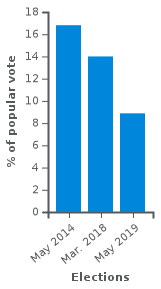
Electoral results
Italian Parliament
| Chamber of Deputies | |||||
| Election year | Votes | % | Seats | +/− | Leader |
|---|---|---|---|---|---|
| 2018 | 4,596,956 (4th) | 14.0 | 106 / 630 |
||
| Senate of the Republic | |||||
| Election year | Votes | % | Seats | +/− | Leader |
|---|---|---|---|---|---|
| 2018 | 4,358,004 (4th) | 14.4 | 58 / 315 |
||
European Parliament
| European Parliament | |||||
| Election year | Votes | % | Seats | +/− | Leader |
|---|---|---|---|---|---|
| 2014 | 4,614,364 (3rd) | 16.8 | 13 / 73 |
||
| 2019 | 2,351,673 (4th) | 8.8 | 7 / 76 |
||
Regional Councils
| Region | Election year | Votes | % | Seats | +/− |
|---|---|---|---|---|---|
| Aosta Valley | 2018 | 1,862 (10th)[lower-alpha 1] | 2.9 | 0 / 35 |
|
| Piedmont | 2019 | 161,137 (4th) | 8.4 | 3 / 50 |
|
| Lombardy | 2018 | 750,628 (4th) | 14.3 | 14 / 80 |
|
| South Tyrol | 2018 | 2,825 (12th) | 1.0 | 0 / 35 |
|
| Trentino | 2018 | 7,204 (10th) | 2.8 | 1 / 35 |
|
| Veneto | 2015 | 110,573 (5th) | 6.0 | 3 / 51 |
|
| Friuli-Venezia Giulia | 2018 | 50,908 (3rd) | 12.1 | 5 / 49 |
|
| Emilia-Romagna | 2020 | 55,317 (7th) | 2.6 | 1 / 50 |
|
| Liguria | 2015 | 68,283 (4th) | 12.7 | 3 / 31 |
|
| Tuscany | 2015 | 112,658 (4th) | 8.5 | 2 / 41 |
|
| Marche | 2015 | 49,884 (4th) | 9.4 | 2 / 31 |
|
| Umbria | 2019 | 22,991 (5th) | 5.5 | 1 / 21 |
|
| Lazio | 2018 | 371,155 (3rd) | 14.6 | 6 / 50 |
|
| Abruzzo | 2019 | 54,223 (4th) | 9.0 | 3 / 31 |
|
| Molise | 2018 | 13,627 (2nd) | 9.4 | 4 / 21 |
|
| Campania | 2015 | 405,550 (2nd) | 17.8 | 7 / 51 |
|
| Apulia | 2015 | 181,896 (3rd) | 10.8 | 6 / 51 |
|
| Basilicata | 2019 | 26,457 (3rd) | 9.14 | 3 / 21 |
|
| Calabria | 2020 | 96,067 (2nd) | 12.6 | 5 / 30 |
|
| Sicily | 2017 | 315,056 (2nd) | 16.4 | 14 / 70 |
|
| Sardinia | 2019 | 56,450 (5th) | 8.01 | 6 / 60 |
- In a joint list with Brothers of Italy.
Leadership
- President: Silvio Berlusconi (2013–present)
- Vice President: Antonio Tajani (2018–present)
- Coordinator: Giovanni Toti (2019), Mara Carfagna (2019), Mariastella Gelmini (2019–present), Anna Maria Bernini (2019–present), Sestino Giacomoni (2019–present)
- Coordinator of Departments: Francesco Giro (2015–2018), Adriano Galliani (2018–present)
- Political Counselor: Giovanni Toti (2014–2018)
- Chief of Staff: Mariarosaria Rossi (2014–present)
- Spokesperson: Deborah Bergamini (2014–2018), Giorgio Mulé (2018–present)
- Organisational secretary: Gregorio Fontana (2015–present)
- Party Leader in the Chamber of Deputies: Renato Brunetta (2013–2018), Mariastella Gelmini (2018–present)
- Party Leader in the Senate: Paolo Romani (2013–2018), Anna Maria Bernini (2018–present)
- Party Leader in the European Parliament: Raffaele Baldassarre (2013–2014), Elisabetta Gardini (2014–2019), Antonio Tajani (2019–present)
Symbols
 Official logo,
Official logo,
2013–present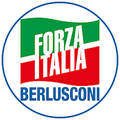 Electoral logo,
Electoral logo,
2014–2018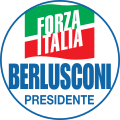 Electoral logo,
Electoral logo,
2018 general election Electoral logo,
Electoral logo,
2019 European election Party flag
Party flag
Notes
- The name is not usually translated into English: forza is the second-person singular imperative of forzare, in this case translating to "to compel" or "to press", and so means something like "Forward, Italy", "Come on, Italy" or "Go, Italy!". Forza Italia! was used as a sport slogan, and was also the slogan of Christian Democracy in the 1987 general election (see Giovanni Baccarin, Che fine ha fatto la DC?, Gregoriana, Padova 2000). See Forza Italia for details.
References
- Paola Di Caro (17 May 2015). "Forza Italia, i tormenti di un partito". il Corriere della Sera.
- Nordsieck, Wolfram (2018). "Italy". Parties and Elections in Europe. Retrieved 18 May 2018.
- Carlo Taormina (28 November 2013). Il Tempo (ed.). "Silvio rialza la bandiera liberale e liberista".
- Woods, Dwayne (2014). The Many Faces of Populism in Italy: The Northern League and Berlusconism. The Many Faces of Populism: Current Perspectives. Emerald Group. pp. 28, 41–44.
- Pietro Ignazi (30 August 2015). "Chi sono i populisti? Lega e Forza Italia. M5s difende le regole". il Fatto Quotidiano.
- Nicolò Conti (2015). "No Longer Pro-European? Politicisation and contestation of Europe and Italy". In Andrea Mammone; Ercole Giap Parini; Giuseppe Veltri (eds.). The Routledge Handbook of Contemporary Italy: History, Politics, Society. Routledge. p. 139. ISBN 978-1-317-48755-5.
- Including the single deputies of Christian Revolution, the New Italian Socialist Party, the Pensioners' Party and Veneto for Autonomy.
- Thomas Jansen; Steven Van Hecke (2011). At Europe's Service: The Origins and Evolution of the European People's Party. Springer. pp. 63–65. ISBN 978-3-642-19414-6.
- Donatella M. Viola (2015). Italy. Routledge Handbook of European Elections. Routledge. p. 115. ISBN 978-1-317-50363-7.
- Patrick McCarthy (2002). Stephen Gundle; Simon Parker (eds.). Forza Italia: the new politics and old values of a changing Italy. The New Italian Republic: From the Fall of the Berlin Wall to Berlusconi. Routledge. p. 135. ISBN 978-1-134-80791-8.
- Diego Gambetta; Steven Warner (2016). Josep M. Colomer (ed.). Italy: Lofty Ambitions and Unintended Consequences. The Handbook of Electoral System Choice. Palgrave Macmillan. p. 244. ISBN 978-0-230-52274-9.
- "Forza Italia membro d'ufficio Ppe come erede del Pdl". Ansa.it (in Italian). 19 September 2014.
- "Italian politics: Not so forza any more". The Economist. 13 August 2015. Retrieved 16 March 2017.
- "Berlusconi al Tg1: torna Forza Italia e sarò io a guidarla" (in Italian). Il Sole 24 Ore. 28 June 2013. Retrieved 28 July 2013.
- "Berlusconi annuncia ritorno di Forza Italia. "Temo che sarò ancora il numero uno"" (in Italian). la Repubblica. 28 June 2013. Retrieved 24 August 2013.
- "Berlusconi Revives Forza Italia in Plea for Help Against Trials". Bloomberg News. 18 September 2013.
- "Silvio Berlusconi Relaunches Forza Italia on Senate Ousting Vote". International Business Times. 18 September 2013.
- "Berlusconi Vows to Stay in Politics if Ousted From Senate". The Wall Street Journal. 18 September 2013.
- "Berlusconi Stakes a Claim for Relevance, but Avoids Threats". The New York Times. 18 September 2013.
- "Berlusconi breaks away from Italian government after party splits". Reuters. 16 November 2013. Retrieved 16 November 2013.
- "È rottura tra Berlusconi e Alfano Il vicepremier annuncia i nuovi gruppi" (in Italian). Corriere della Sera. 16 November 2013.
- "Alemanno lancia "Prima l'Italia": "La priorità è portare il Paese fuori dalla crisi"" (in Italian). Il Messaggero. 13 October 2013.
- "L'addio al Pdl (in frantumi), rinasce Forza Italia" (in Italian). Corriere della Sera. 16 November 2013.
- "Nel Pdl colombe pronte alla battaglia E il partito ora rischia la scissione". Archiviostorico.corriere.it. Retrieved 10 July 2014.
- "Fitto: noi lealisti non vogliamo posti Azzerare tutto e poi congresso". Archiviostorico.corriere.it. Retrieved 10 July 2014.
- "Pdl, tanti no all?ipotesi del congresso". Archiviostorico.corriere.it. Retrieved 10 July 2014.
- "Il Pdl e la sfida sugli incarichi Si affacciano i mediatori". Archiviostorico.corriere.it. Retrieved 10 July 2014.
- "Nasce Forza Trentino: ultimo pressing su Mosna" (in Italian). Trentino (newspaper). 11 September 2013. Archived from the original on 29 October 2013. Retrieved 26 September 2013.
- "Biancofiore candida l'Artioli capolista" (in Italian). Alto Adige. 14 September 2013. Archived from the original on 21 September 2013. Retrieved 26 September 2013.
- "Alle 17.42 l'annuncio dopo il voto palese L'ira di Forza Italia sui Cinquestelle" (in Italian). Corriere della Sera. 28 November 2013.
- "Confermata la condanna Berlusconi sconterà 1 anno". Archiviostorico.corriere.it. Retrieved 10 July 2014.
- "Forza Italia esce dalla maggioranza Alfano: "Un errore sabotare Letta"" (in Italian). Corriere della Sera. 26 November 2013.
- "Berlusconi, Alfano: no alla decadenza. Grasso: nessun rinvio sul voto". Ilmessaggero.it. Retrieved 16 March 2017.
- "Decadenza Berlusconi, Alfano: una brutta giornata per la democrazia". Avvenire.it. 27 November 2013. Retrieved 16 March 2017.
- "Mediaset, cambio ai vertici Al posto di Giovanni Toti arrivano Giordano e Broggiato" (in Italian). il Giornale. 24 January 2014. Retrieved 25 January 2014.
- ""Forza Italia via dai palazzi romani" Si riparte da Milano (e dalla Brianza)" (in Italian). Corriere della Sera. 29 November 2013.
- "Forza Italia - Responsabili Uffici e Dipartimenti nazionali". Archived from the original on 21 February 2015. Retrieved 9 June 2015.
- "Berlusconi taps newsman as party advisor". Agenzia Nazionale Stampa Associata. 24 January 2014. Retrieved 24 January 2014.
- "Ministero dell'Interno Archivio Storico delle Elezioni - Europee del 25 Maggio 2014". 25 May 2014. Retrieved 9 June 2015.
- "Fi, Fitto lancia i "ricostruttori" "Stiamo e saremo nel partito"". Corriere della Sera. 21 February 2015. Retrieved 9 June 2015.
- "Dall?ex tesoriere ai pugliesi: chi sta con Fitto E Verdini prova ad assottigliare la pattuglia". Retrieved 9 June 2015.
- "Lotte intestine e mosse del governo Berlusconi ora si sente sotto assedio". Retrieved 9 June 2015.
- "Forza Italia, la mappa del partito: nomi e cognomi, ecco tutte le correnti e i loro obiettivi". Retrieved 9 June 2015.
- "Italicum, oggi voto finale. Letta: Mattarella non firmi - Pagina Nazionale - il Tirreno". Iltirreno.gelocal.it. 4 May 2015. Retrieved 16 March 2017.
- "il manifesto". Retrieved 9 June 2015.
- "Bondi e Repetti, ora l?addio è definitivo Nel partito è guerra generazionale". Retrieved 9 June 2015.
- "Berlusconi a tutto campo. Lite con Bondi E in Puglia il candidato va con Fitto". Retrieved 9 June 2015.
- "Chiuso l?accordo Lega-Forza Italia con Zaia in Veneto e Toti in Liguria". Retrieved 9 June 2015.
- "Berlusconi-Alfano, intesa in Campania È rottura con Fitto". Retrieved 9 June 2015.
- "In Puglia Berlusconi lancia Poli Bortone: è caos". Retrieved 9 June 2015.
- ""Poli Bortone dice sì". Toti: ora Fitto si allinei". Retrieved 9 June 2015.
- "Berlusconi fa le liste. E c?è il caso Toscana". Retrieved 9 June 2015.
- archiviostorico.corriere.it/2015/maggio/18/addio_Fitto_Pronto_gruppo_Senato_co_0_20150518_53b05284-fd1e-11e4-b125-7cf77d869e07.shtml
- "Fitto, nasce associazione Conservatori e Riformisti". ANSA.it. 19 May 2015. Retrieved 9 June 2015.
- "Archived copy". Archived from the original on 7 November 2015. Retrieved 18 August 2015.CS1 maint: archived copy as title (link)
- "FI, gruppo Camera fa i conti: ipotesi scissione Fitto 'vale' 1 milione di euro". Adnkronos.
- "Raffaele Fitto, con lui dodici senatori: ecco i nomi". Affaritaliani.it.
- "News // ECR Group". ECR Group.
- "Denis Verdini lascia Forza Italia: "Con Berlusconi posizioni distanti, vado via"". 23 July 2015.
- "Alfano, Bondi, Fitto, Verdini: Due anni di addii a Berlusconi". 29 July 2015.
- "Il lento declino del Berlusconi politico e il centrodestra non sa più dove andare". 24 September 2015.
- "Una poltrona per due: Salvini e Parisi in guerra per la leadership". Il Sole 24 ORE. 14 November 2016. Retrieved 16 March 2017.
- Pubblicato: 12 November 2016 20:43 CET (12 November 2016). "Donald Trump esalta e divide il centrodestra. Salvini contro Parisi, trumpisti contro moderati. Berlusconi fa la sua scelta". Huffingtonpost.it. Retrieved 16 March 2017.
- Altri articoli dalla categoria » (12 November 2016). "Salvini a Firenze: "Pronto a fare il leader del centrodestra" - Repubblica.it". Firenze.repubblica.it. Retrieved 16 March 2017.CS1 maint: extra punctuation (link)
- Redazione ANSA (15 November 2016). "Centrodestra: Berlusconi scarica Parisi, non può avere un ruolo se in contrasto con Salvini - Politica". ANSA.it. Retrieved 16 March 2017.
- Valentina Santarpia (15 November 2016). "Berlusconi scarica Parisi: "No a ruoli per lui se resta contrasto con Salvini" La replica di Parisi: "Io vado avanti". Corriere.it. Retrieved 16 March 2017.
- Redazione ANSA (18 November 2016). "Parisi launches new center-right party - English". ANSA.it. Retrieved 16 March 2017.
- Raffaella Cagnazzo (18 November 2016). "Centrodestra, Parisi lancia il nuovo movimento 'Energie per l'Italia': «Rinnovamento radicale dal basso". Corriere.it. Retrieved 16 March 2017.
- "Parisi lancia ŤEnergie per l'Italiať: alternativi a Renzi e Grillo". Il Sole 24 ORE. 18 November 2016. Retrieved 17 March 2017.
- "senato.it - Senato della Repubblica senato.it - Variazioni nei Gruppi parlamentari". www.senato.it.
- "Camera.it - XVII Legislatura - Deputati e Organi Parlamentari - Composizione gruppi Parlamentari". www.camera.it.
- "Governo, si è dimesso ministro Enrico Costa: "Niente ambiguità"". 19 July 2017.
- Scafuri, Roberto. "Costa lascia il governo Via al partito centrista che nasce contro Alfano". ilGiornale.it.
- "Berlusconi accoglie i centristi. Pronto il nome: "Italia Civica"". LaStampa.it.
- "E Berlusconi ordinò: "Fermate l'esodo o cade l'esecutivo"". Il Fatto Quotidiano.
- "TRA QUARTE GAMBE E BAD COMPANY, VIAGGIO NELLA GALASSIA CENTRISTA IMPLOSA PER L'ANSIA DA SEGGIO". 20 July 2017.
- Stefanoni, Franco (12 March 2017). "Fratelli d'Italia: via An e Msi dal simbolo. Entra Santanchè: "Tornata a casa mia"". Corriere della Sera.
- Online, Redazione (3 February 2018). "Chi è Antonio Tajani, il candidato premier scelto da Berlusconi". Corriere della Sera.
- "Forza Italia, Berlusconi nomina Tajani suo vice. Galliani coordinatore dei dipartimenti". Repubblica.it. 5 July 2018.
- Greco, Anna Maria. "La svolta di Forza Italia: Tajani vice di Berlusconi". ilGiornale.it.
- "Berlusconi promuove Galliani, nuove gerarchie in Forza Italia. Ma la scelta scatena una guerra nel partito". www.liberoquotidiano.it.
- "Berlusconi: "Non sarò capolista ovunque, Tajani al centro"". Adnkronos.
- "Verso le Europee, ecco i principali candidati dei partiti italiani". 12 April 2019.
- Oltermann, Philip; Walker, Shaun; Giuffrida, Angela (27 May 2019). "An NBA star, a TV chef and a comedian: meet some of the new MEPs" – via www.theguardian.com.
- "Forza Italia, Berlusconi: Carfagna e Toti coordinatori nazionali". Repubblica.it. 19 June 2019.
- "Toti: alleati con Lega e FdI, qui vogliamo restare - Politica". Agenzia ANSA. 1 August 2019.
- "Fi, Toti dopo l'addio lancia il tour del suo movimento politico e si rivolge a Salvini. Carfagna resta nel partito". Repubblica.it. 2 August 2019.
- Silvio Berlusconi (25 April 2016). "Silvio Berlusconi: "Ecco dove va Forza Italia"". il Giornale.
- unknown (9 September 2017). "Berlusconi candida Fi alla guida del centrodestra: "Dobbiamo tornare a governare"". la Repubblica.
- Askanews (2 May 2017). "Berlusconi:ora progetto governo liberal-riformatore centrodestra". Tiscali.
- Editorial Staff (25 April 2016). "Berlusconi chiarisce: "Noi non siamo di destra. Ecco dove va Forza Italia"". Secolo d'Italia.
- "Berlusconi seeks return to liberal roots". Financial Times. 22 July 2012.
- Serenus Zeitblom (11 April 2015). "Berlusconi e il cerchio magico... scelto da lui".
- "Silvio Berlusconi, le badanti del cerchio magico e le profezie di Veronica Lario". l'Espresso. 28 June 2016.
- "Un doloroso retroscena. Berlusconi contro Toti, così è finita malissimo". www.liberoquotidiano.it.
- "Sconcerto da Tajani e Cav, Toti sceglie Salvini. Occhio, perché lui corre da solo. Sotto sotto..." www.liberoquotidiano.it.
- "Pd-azzurri: asse sui diritti (senza Ncd)" (in Italian). Corriere della Sera. 4 January 2014.
- ""Dico sì a unioni gay e ius soli" Un altro asse Berlusconi-premier". Retrieved 9 June 2015.
- Feo, Fabrizio de. "Unioni civili, confronto in Forza Italia". ilGiornale.it.
- "Unioni civili e adozioni, Pd diviso Berlusconi: "No al ddl Cirinnà"". Corriere della Sera. 13 January 2016.
- "Unioni civili sono legge: M5s si astiene. Lega e Fdi contro. Renzi: "E' un giorno di festa". Le destre: "Referendum" - Il Fatto Quotidiano". 11 May 2016.
- "Forza Italia rilancia". Archivio - la Repubblica.it.
- "Aborto e nozze gay, ecco come hanno votato gli italiani a Strasburgo". www.lanuovabq.it.
- "La Camera approva la legge sul biotestamento. I deputati cattolici: "E' eutanasia"". LaStampa.it.
- Neve, Giovanni. "Migranti, Berlusconi: "Un accordo con la Libia è l'unica soluzione"". ilGiornale.it.
- Romano, Luca. "Ius soli, Berlusconi: "La cittadinanza va meritata"". ilGiornale.it.
- Italia, Movimento Forza. "Forza Italia - Gasparri: Il professor Veronesi sbaglia, liberalizzare la droga non indebolisce la mafia". www.forzaitalia.it.
- http://www.cesdop.it/public/Scheda%20droga%20e%20legge.PDF
- "Esporre il crocifisso nelle aule consiliari, la mozione di Forza Italia - gonews.it". 3 July 2017.
- "Berlusconi: "No a patrimoniali e aumenti Iva, flat tax al 23%"". Il Sole 24 ORE.
- "Fi, Berlusconi sul palco di Fiuggi. Coro dalla platea: "Un presidente, c'è solo un presidente"". 17 September 2017.
- "Quegli economisti euroscettici (proprio come Berlusconi)" (in Italian). Il Foglio. 31 October 2011. Archived from the original on 14 May 2014. Retrieved 22 January 2014.
- "Can Berlusconi make a eurosceptic comeback?". la Repubblica/The Guardian. Presseurop. 26 June 2012. Archived from the original on 4 February 2014. Retrieved 22 January 2014.
- "Berlusconi turns Eurosceptic in bid to return to power". City A.M. 18 July 2012. Retrieved 22 January 2014.
- Paola Tavola (28 June 2017). "Tajani: "Centrodestra vince se guida Forza Italia. Europa da cambiare, ma non in discussione"". Euronews.
- Goffredo De Marchis (18 August 2017). ""Silvio, pensaci tu". Merkel e Berlusconi, l'asse anti-populisti". la Repubblica.
- Flavia Perina (5 August 2017). "Berlusconi abbraccia la Merkel e l'europeismo, ed era ora". Linkiesta.
- Marco Damilano (31 August 2017). "Coalizione alla tedesca: la Merkel "riabilita" Berlusconi per un governo Pd-Forza Italia". l'Espresso.